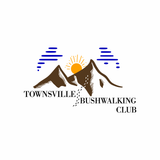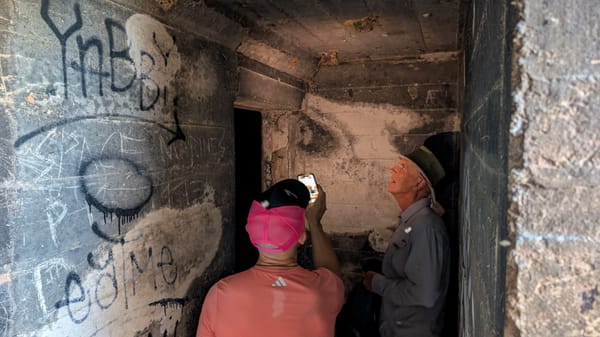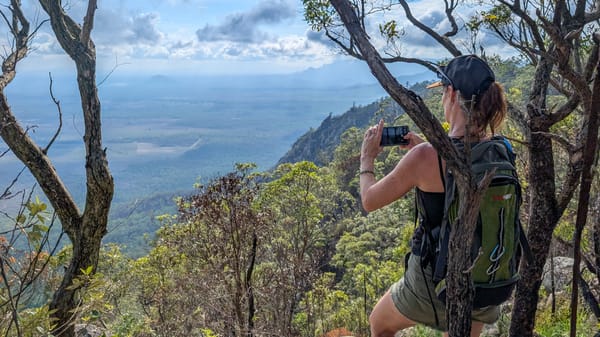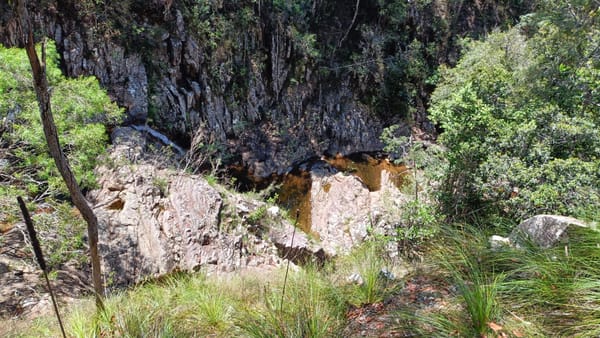Escape Magazine - October 1988
Escape Oct 1988: Townsville Bushwalkers magazine—new meeting venue, growing membership and finances update. Trip reports span Dalrymple Track, Mt Spec walking tracks, Waterview Creek and Chillagoe limestone caves. Also: spider guide, club history, farewell to Dave. North Queensland hiking.
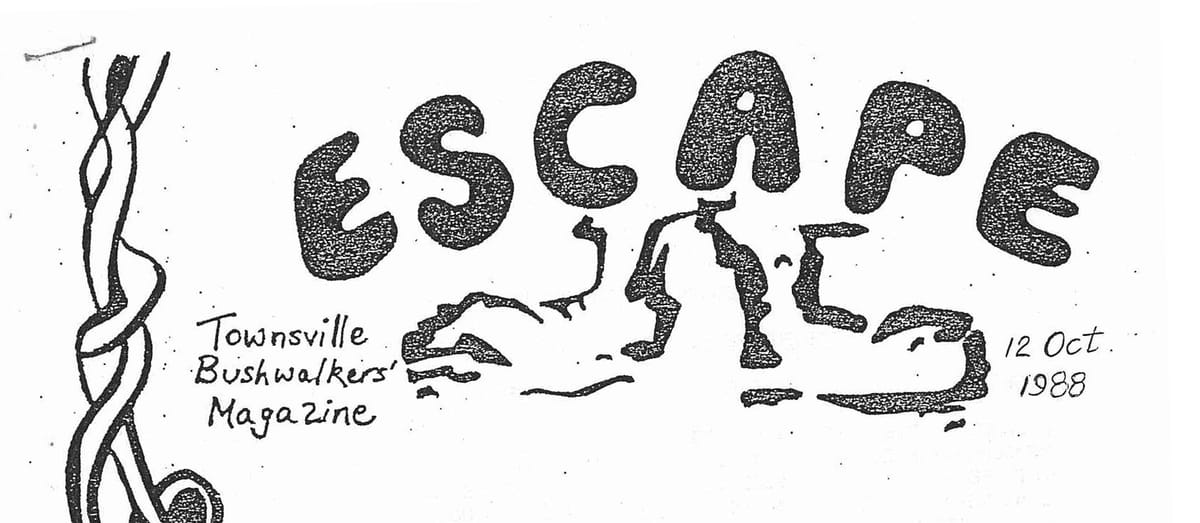
ESCAPE Townsville Bushwalkers' Magazine
12 Oct. 1988
Dear Readers,
Here you have our second magazine of 1988. It has taken some time (i.e. months and months) to gather this issue together. Thanks to all who have contributed. . . Charlie, Alan, Mark, Harry, and Wendy.
Mary Jane.
NEW VENUE
Due to ongoing venue difficulties, we've moved again. We now hold our fortnightly meetings at "Charlie's Place". Thanks Charlie.
MEMBERSHIP
A few weeks ago Charlie placed an ad in the Notice Board section of Wednesday's Townsville Bulliten. It states our existance and gives Marion and Graham are contacts. Subsequently, recent meetings have seen several new faces. Some visitors have even come back a second time! Welcome.
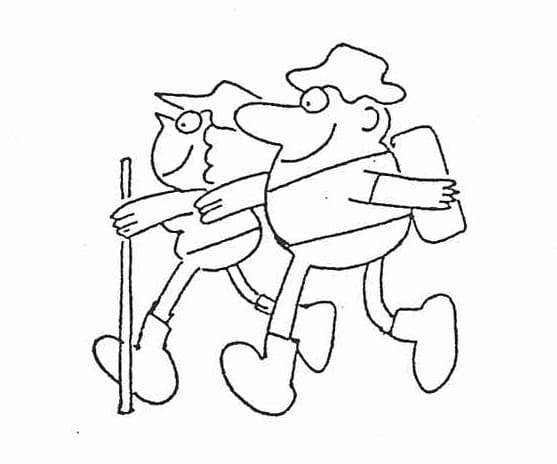
TOWNSVILLE BUSHWALKERS
TREASURERS REPORT 1/2/87 - 1/2/88
| RECEIPTS | AMOUNT | PAYMENTS | AMOUNT |
|---|---|---|---|
| BALANCE CARRIED FWD | $ 560.33 | FEDERAL TAX | $ 11.15 |
| MEMBERSHIP FEES | $ 103.00 | DRIVER REIMBURSEMENT | $2370.00 |
| TRIP FEES | $2523.00 | LOAN TO NQCC | $ 300.00 |
| LOAN REPAY. NQCC | $ 300.00 | HINCH. DEPOSIT | $ 200.00 |
| HINCH. DEPOSIT | $ 200.00 | DONATION BOY SCOUTS | $ 60.00 |
| DONATION VINCENT SCHOOL | $ 35.00 | ||
| DONATION PALUMA FIELD STUDY CENTRE | $ 35.00 | ||
| SUBS. WILDERNESS SOCIETY | $ 27.00 | ||
| PURCHASE URN | $ 76.64 | ||
| INSURANCE | $ 72.90 | ||
| NEWSLETTER (PHOTOCOPYING & INCIDENTALS) | $ 195.82 | ||
| P.O. BOX | $ 23.00 | ||
| BANK BALANCE | $ 279.82 | ||
| -------- | $3686.33 | -------- | $3686.33 |
Our bank balance indicates that expenses have exceeded our income by $280.51 for the twelve months. However by increasing our membership fees & significantly reducing the cost of photocopying for the newsletter we can hope to avoid a repeat of this decline in our finances for this period. It should also be noted that the donation to the boy scouts really belongs to the preceding financial period.
ALAN WATSON
WISHING DAVE FAREWELL
The Bushwalkers are alive and strong if the attendance at a recent barbeque is anything to go by. (I still think it should be called "The Townsville Bush Social Group" as we have more members attending our social functions than the walks. I shouldn't talk too loudly or my membership might be cancelled due to never walking.) It was good to see the large turn out as we were there to send Dave Whyte and his family off to Canberra. Dave has landed a job there and the whole family is off to the cold capital.
The barbeque was hosted by Allan and Barbara and we had a mixture of barbeque and pot luck. I think that it was the best barbeque that the club has had for a long time. Allan and Barbara's large yard enabled the children to run around somewhere else while the rest of us stood around the fire, staying warm (yes, it was cold) and eating all the great food that turned up.
It was sad to see Dave go as he was a strong supporter of the Club. (He even went on walks.) He will be missed by all the members with the exception of those who went on the Cape Cleveland and Yamine Falls walks. Charlie, on behalf of the Club, presented Dave with a parting gift of the new book on Hinchinbrook Island, something for him to drool over when the temperature drops below 10°. Also, a few of the members got together (not mentioning any names) and presented Dave with a trophy made from Northern Silky Oak (but I'm sure it was recycled timber). I can't remember the exact wording on the trophy but it was very clever and I'm sure Dave will treasure it.
The night was topped off when the hangers-on joined Allan in a bottle of wine that he had been saving for a long time. It was worth the wait.
So, Dave, if you read this (do magazines get sent to Canberra?) we miss you and will remember both you and the party that sent you off.
Signed . . . A Regular Party-goer (but Irregular Walker)
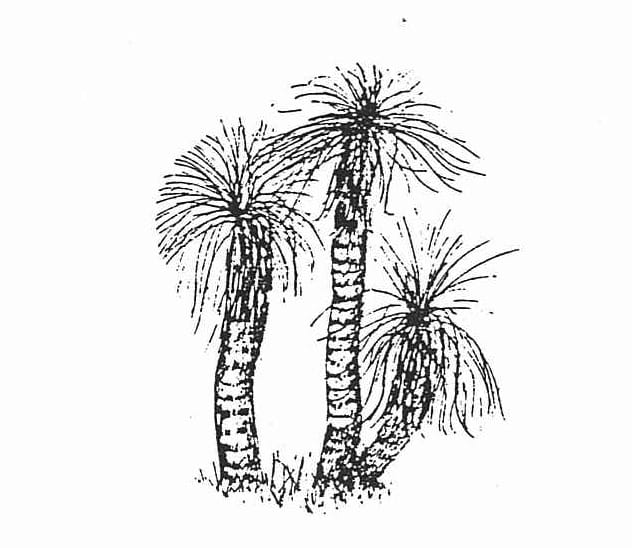
HISTORY
Soon after the establishment of a settlement at Rockingham Bay (Cardwell) in 1864, George Elphinstone Dalrymple began exploring the area to the west of the township (Meunga - Kennedy Ck. area).
The following extract is taken from a report he produced describing the exploration. Perhaps it will bring back memories to those who were involved in the Kennedy tracks walk in 1987.
On the 4th of February I ascended the range, and leaving Lieutenant Marlow and trooper Norman outside, with troopers Warbragen and Archy, cut my way up to the summit, through the densest vine and thorn jungle I ever met with, even in the East Indies. Besides an undergrowth of smaller thorny bushes, a perfect network is formed of cane creepers, of various dimensions, covered with hook-shaped thorns, which catch one by the face, back, hands, and legs, so that not only were our clothes nearly torn to ribbons, but we returned to the outside all scratched and bleeding, and our hands and wrists so full of poisonous thorns, that on my return to the settlement I was forced to put both hands in poultices.
CHARLIE
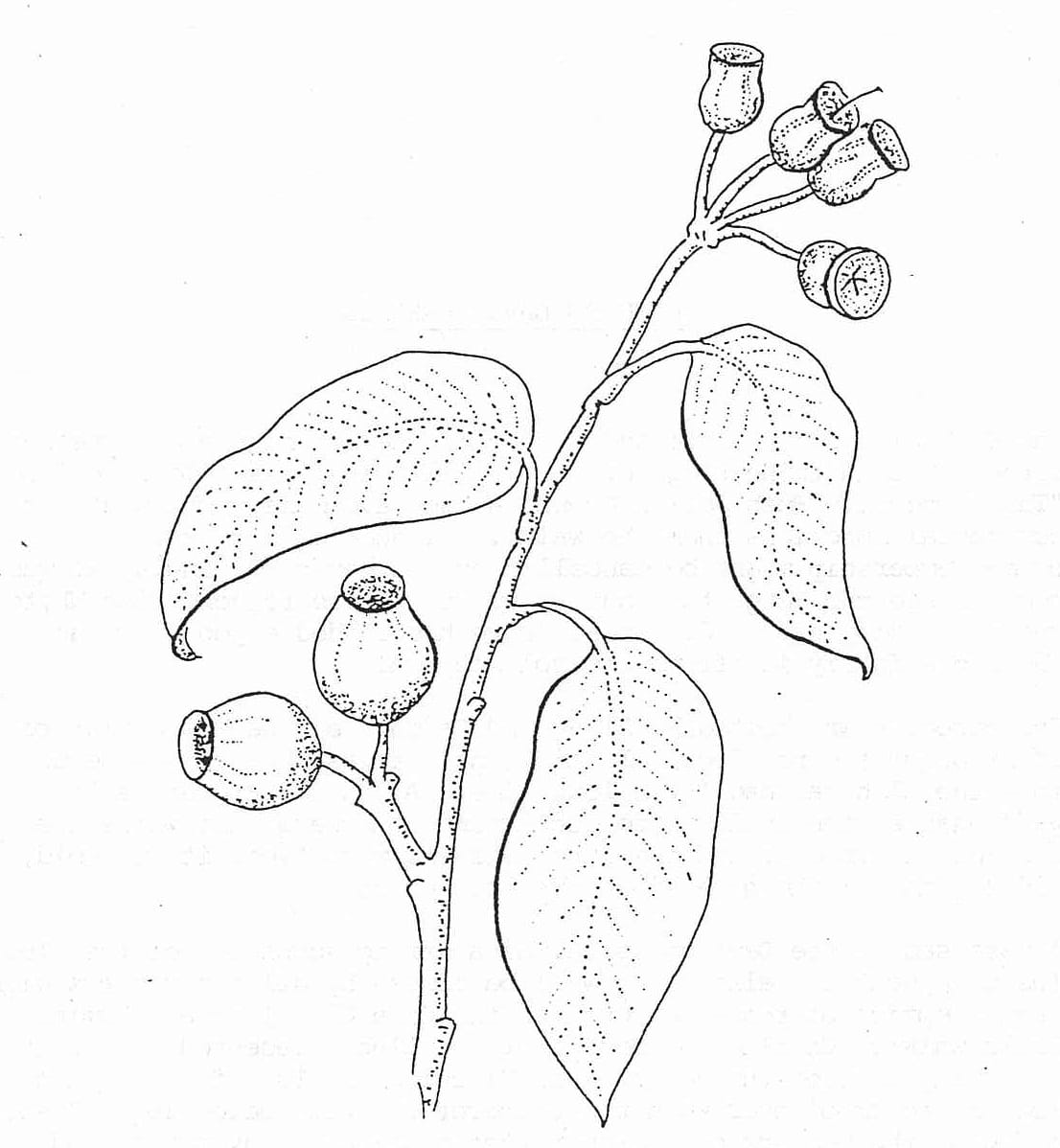
MT SPEC WALKING TRACKS
This walk is always a good one for those who want a quiet laid-back weekend with just enough exercise for you not to feel guilty. The walk on the 6th and 7th of August achieved just that.
A small group including, Barbara, John, visitors Carsten and Karin, Charlie, and myself set out to do the walk. Leaving the vehicles at the usual spot we walked to Johnson's Clearing by lunchtime. The only difference on this walk was that Charlie and I were determined to update Cameron McKenzies mud-map. Although the others weren't aware of it, that was why Charlie and I took a side track that led to the dam. In fact, I don't think we even discussed it with each-other. How can you make an accurate map if you don't know where the side tracks lead? That's my excuse anyway.
Lunch was spent at Johnson's with the group solving most of the world's problems, once again. The afternoon swim in Gold Creek was freezing. Even our German friends found it cold. As usual, that evening there was enough food passed around that the calories burnt off during the day were more than adequetley catered for.
After expounding on the dangers of leaving food lying around, it was disappointing to find that Carsten and Karin didn't get an opportunity to see some of the white tail rats that have been so prolific in the past.
Sunday was spent walking to Shay's via Foxlee's and Guarde's Lookouts. Care should be taken in following the track from the JA tree to Guarde's Lookout as this section is very indistinct from lack of use. It is flagged but much of the flagging has been eaten off by ants.
With the weather being cloudy and cold no swims in Waterfall Creek were had and a quick lunch near Shay's Clearing was taken. By this time the seasoned walkers were already discussing the afternoon tea menu at Paluma. After all, we were entitled to some rewards after a gruelling two day march. The problem was that there were two tea houses to choose from. The Kookadoodle Inn (excuse the spelling) was chosen. In my opinion it was the wrong choice.
It was an enjoyable weekend witht he only disappointment being that Karin and Carsten didn't get an opportunity to see some of the wildlife in the area. With the Club being dubbed "Bush Appreciation Club", I was surprised that more members didn't come on this relaxing walk.
GRAHAM
A DAY TRIP ALONG THE DALRYMPLE TRACK
You may not have realized it, but the week of 24 - 31 July was Recreation Week.
Quite some time ago the Club received a letter from the Recreation Council asking if we would like to participate in the week's festivities, especially as their theme for 1988 is " Discover Life on a Trail". The Club acted on the Council's suggestion and sponsored a day walk for the general public along the historic Dalrymple Track. This is what happened:
At 7:15 on Sunday the 25th lots (and lots) of people gathered outside the John Herbert Centre on Charters Towers Road. It was a cool (cold?) morning and one club member, a Canadian no less, (who will remain nameless) was seen sporting a pair of woolen gloves!
The Recreation Council had organized a coach to transport we eager day-trippers and at 7:30 we piled on, northward bound.
En route we picked up three hitch-hikers and a bag on lovely tangelos. We made a "rest" stop at Ingham. Some people "rested", others dashed off to make last minute purchases of important bushwalking equipment ie. chocolate.
At 9:30, or thereabouts, we disembarked at the start of the Dalrymple Track. Club members littered themselves among the visitors, showing the way, answering questions, and explaining various points of interest along the track.
We saw some healthy specimens of gympie bush, some lovely Licala palms, and even a tree of oranges. The stone bridge and supposed old grave gathered interest and some of the party's more energetic members were seen climbing the huge old fig tree.
Our last rest stop was along the creek where we had lunch and billy tea. After a pleasant lunch and conversation, we headed back.
We dropped our three hitch-hikers back at their respective roadside spots and arrived back in Townsville in the late afternoon. All in all, it was a successful joint venture between ourselves and the Recreation Council and a very enjoyable Sunday.
MARY JANE
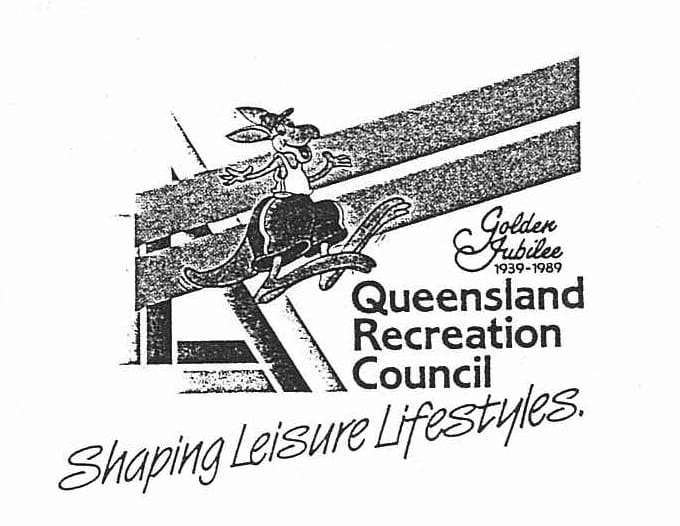
THE MAD WOMAN AND THE PAINTER
The following episode, though it has nothing to do with bushwalking, must come under the sub-title of adventure, for, when one's life is threatened, how can it be otherwise. I have deemed it such, and have included it, consequently, in my personal adventure book, Green Daylight.
* * * * * * *
Another strange thing happened to me, for which an apt title must be, "The Mad Woman and the Painter".
It was the winter of the lasttale I wrote you - I was 22, and at the peak of my pot-holing and climbing adventure, and, though small, I was exceedingly strong. I stress this for it was this strength that got me out of the Mad Woman's clutches.
We were painting K-Ward, in common parlance, the Women's Loony Bin, and had arrived at the foot of the large staircase. During our stay there we were very surprised that some of the inmates were allowed freedom to come and go as they pleased - not a little disconcerting! The weather was miserable, getting well into December, which, in the north of England is surely the most dreary month. So, we had the dim lights on all day, poking around the stairway and entrance hall. George Lye and I had painted the dados - about 5 ft. high up the walls - and now it was left to me to paint the skirting boards, with the same thick, red-brown oil colour, that, in this cold weather, took all of two days to dry. We had pulled out all the cupboards, large and small, away from the walls, making a corridor that led to the underneath of the descending stone steps. I was "cruddled down" - both feet on the ground, legs well bent, to reach down to the skirting, working towards the steps corner in this corridor peering my best not to miss any in this half-light, when I felt the Mad Woman's hands close around my neck! I immediately shot upright, and, feeling her body beside me, flung her, with all my might, wasy, along the wall! She put out a hand to save herself, but it only slid furrows through the wet paint, and brought her arm, side, neck, and enen stockings in contact with the "goo"! In her propulsion, she had kicked over my half-pot of paint before her and, as she gyrated along the slippery wall, turned on her back, and finally came to rest in this pool of paint! A female screech "What the Hell. . ." came from Sister, as she pushed past me to the aid of what had been, a few moments before, the prettiest and daintiest STUDENT NURSE in her flock! Yes, Sister, who was involved in the root cause of this horrible "dommage" still had the damning evidence in her hand - a small sprig of CHRISTMAS MISTLETOE!
HARRY
CHILLAGOE
I'd always wanted to go to Chillagoe and so one September morning we left behind us the lush, green tranquility of the Tablelands and made our way through the tobacco and rice fields west of Mareeba. The land became drier and somewhat less attractive as we journied on, and in fact, as we arrived at a very dry, very dusty, and very small Chillagoe, I wondered if my interest hadn't been misplaced! We quickly dismissed the temptation to turn 180° and instead set about finding a place to camp.
The National Park camping area is a few kilometres outside Chillagoe, at Royal Arch Cave. We went to have a look. Drinking water was available but not showering facilities. As well, the entire area had been burnt off the day before. It was still smoldering and looked terribly sad and desolate. We camped at a caravan park in town.
There are 407 known caves in the Chillagoe area and a very active caving club. Two of caves are open to the public for tours guided by rangers from the local Ranger Station. There are a few other caves open for people to explore on their own. These are described in a park brochure and clearly sign-posted in the park area.
On our first afternoon, after filling up on ice-cream and cold drinks, we set off to do a little non-guided caving. We explored Bauhinia and Pompeii caves, wandered over the limestone bluffs, and worked at becoming aclimatized.
Our second day began with a stop at the Ranger Station. To participate in a guided tour you must sign-on with the ranger immediately before the tour. The Ranger Station is open twice daily only: 8-9 am and 1-1:30 pm. (Good luck if you try to get information at any other time!) You drive your own car to the cave entrance and the ranger meets you there.
Our morning tour was through Donna Cave. This cave is a vertical crack in the rock. It is small with many levels, false floors, etc. It is lit inside so torches are not necessary. The name "Donna" came about because when you first enter the cave there is a formation which looks like the head of a woman. Originally it was named the Madonna Cave.
The Ranger, Dave, filled us in regarding caves and their formation. He explained that the limestone in Chillagoe was deposited there as coral reefs about 400 million years ago when the area was a shallow sea. Today the limestone is above the ground, rising in towers to 70m. Underground, over long years, the mild acid solution has seeped into the cracks and other areas of weakness in the limestone dissolving it to form caverns and tunnels. The redeposited limestone forms the lovely "decorations" inside the caves. Ranger Dave also explained that Chillagoe's caves are quite different to those found south, say at Jenolan. Chillagoe has much older formations which have, for the most part, stopped "growing". At Jenolan the caves are still young and active.
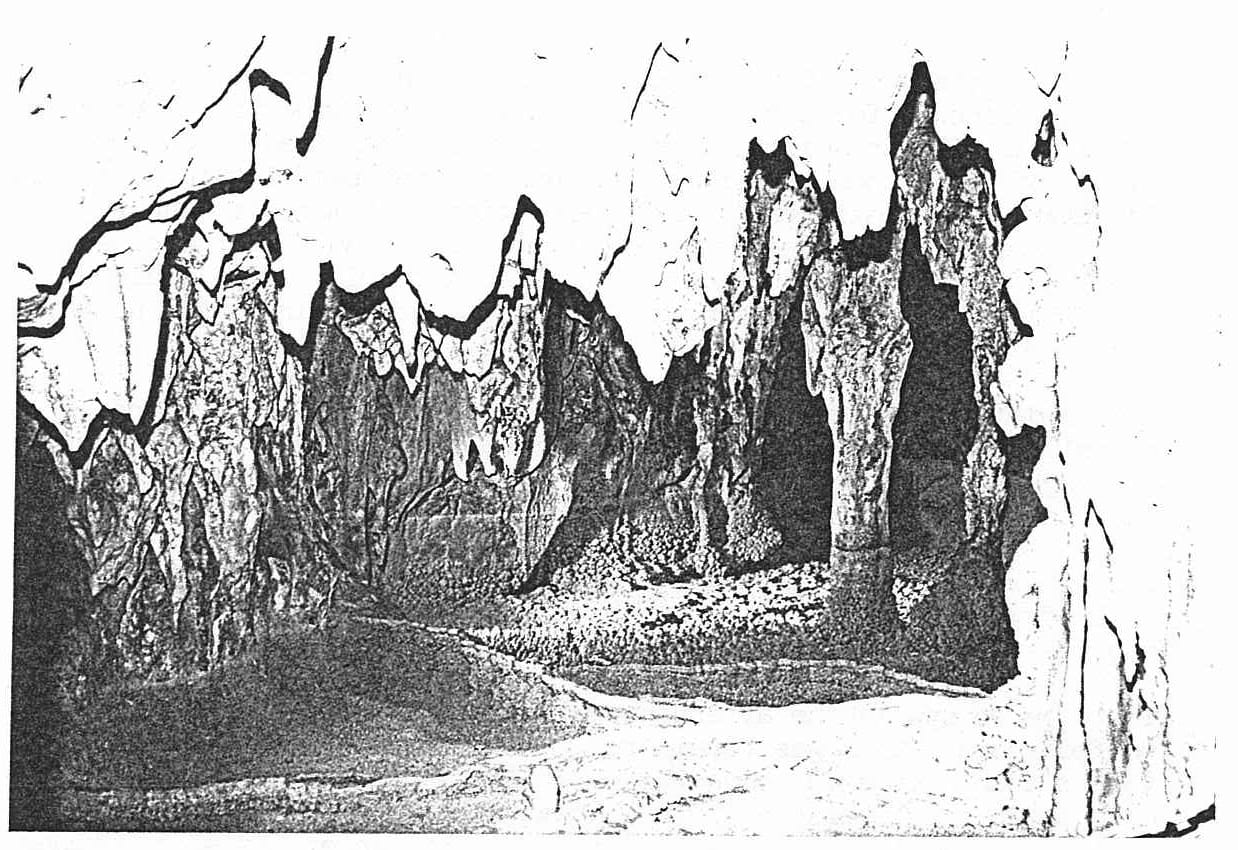
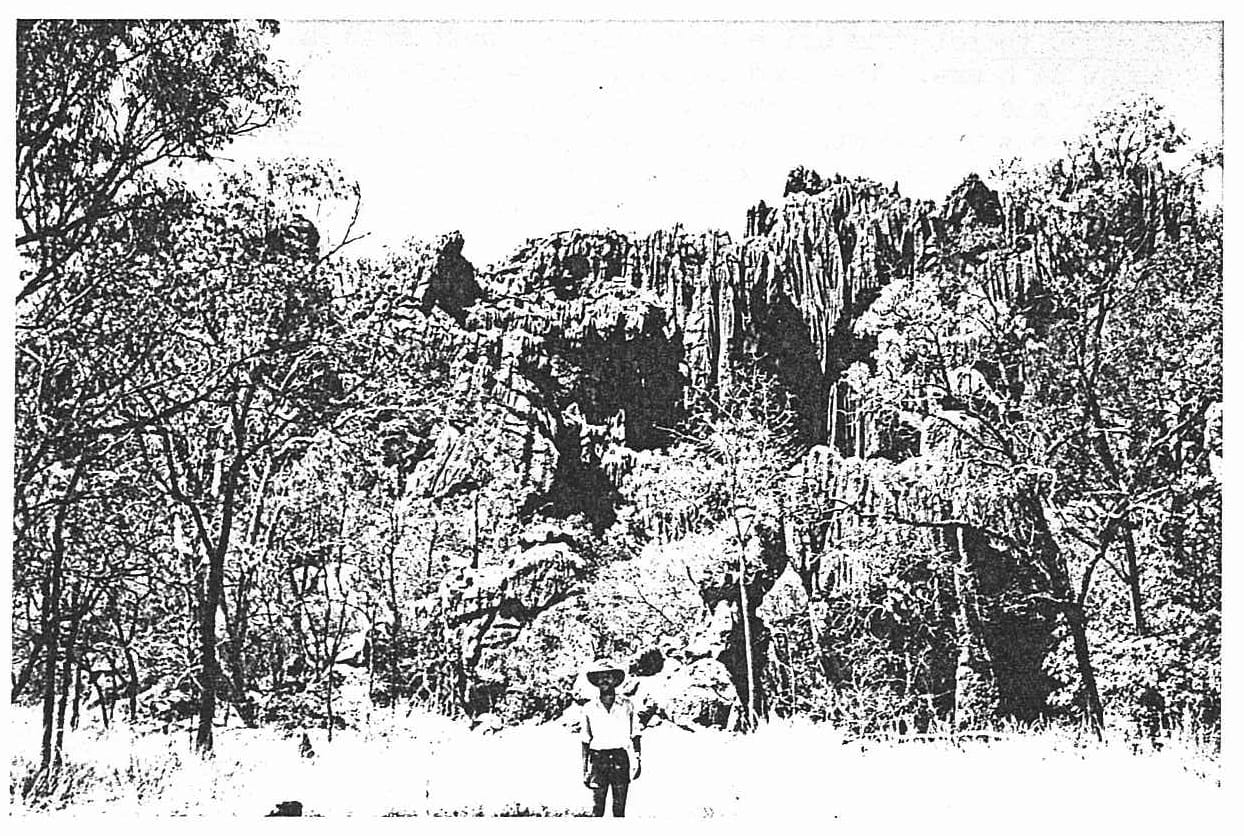
Left: Limestone formations inside Donna Cave; Right: Limestone bluffs at the Archways. Note local "bush man" in the foreground.
As we left the Donna Cave we could see that a further passageway had been blocked for public use. When we asked Ranger Dave about it he told us that swiftlets nests beyond the barricade. Chillagoe is one of five known nesting sites for the grey swiftlet in Australia. Swiftlets, like bats, have an echo-location system and so can fly in black caves. Their nests are made from saliva and kangaroo grass and are yummy in soup - according to some people. If disturbed the birds go beserk, flying into the walls, destroying their nests, eggs, and themselves.
The guided cave tours last from about 1½ to 2 hours so we found ourselves with time to spare before the 1:30 tour and made our way to Mungana, 15 Km from Chillagoe where we explored the Archways, ate lunch, and admired some Aboriginal paintings.
The Archways are old caves that have "caved-in". They are an "open daylight cave system" and provide a home for various wildlife, fig trees, and maidenhair ferns.
The cave we saw in the afternoon was my favourite of the two guided tours. This was Royal Arch Cave. It is a horizontal, rather than a vertical crack like the Donna Cave, and instead of many different levels in a small area, it has a maze of passages all on the one level. This cave isn't lit. The ranger has some torches to lend but not always enough to go around so it is best to bring your own just in case (and spare batteries!). The approach taken by Ranger Dave was different from the morning's tour. This time we were encouraged to explore on our own, to squeeze through crannies, to crawl through tunnels. It was good fun.
Getting there: The drive to Chillagoe, west from Mareeba, takes about 1½ hours. The road is paved in sections and is undergoing a fair bit of work in others. Chillagoe sports a general store, a take-away, two motels, a pub, and a couple of caravan parks. If you decided to visit, you'd be best advised to take all foodstuffs, liquid refreshment, petrol, etc. you'll need with you as prices are high on the far side of the range.
Despite the dust, the arid air, the price of beer, and its somewhat unimpressive appearance, we had an interesting and fun-filled two days in Chillagoe.
MARY JANE
WON'T YOU COME INTO MY PARLOUR
There are many spiders which you are likely to find in your suburban yard in Townsville provided you have a reasonable number of shrubs, trees, etc.
Surprisingly, most Families of spiders do not build traditional wheel-shaped (orb) webs, they don't spin webs at all! However, because orb webs are obvious, orb web spiders seem more common than others. One of the most colourful and easily spotted orb web spider is the St. Andrews Cross spider (Argiope aetherea). This large spider sits in her web strung between bushes wearing bright yellow and brown stripes. She often makes a distinctive X out of thick white silk which gives her her common name. The male is much smaller and dark brown. He often gets eaten while attempting to mate. Cannibalism is quite common with the orb or wheel web spiders where the female is much larger than the male.
Another common orb spider is the Garden spider (Eriophora transmarinus) which builds a large web between bushes. You are more likely to encounter the web by walking into it than to see the spider as she hides under a leaf during the day.
Of the spiders that don't build webs, an attractive group are the Flower spiders (Family Thomisidae) which live on plants and catch their prey by ambush. They are mostly small and are predominantly green, yellow or white. A family of captivating little spiders that most people have seen are the jumping spiders (Fam. Salticidae). These are characterized by their two large eyes, swivelling head and their curiosity. These spiders also live on foliage and catch their prey by ambush. They come in a great variety of colours. The large green one around Townsville is Mopsus mormon. On the ground live wolf spiders (Lycosidae), little brown spiders which run out of the way of danger often carrying their egg cases with them. They live under leaf litter and hunt their prey.
Inside the house live the very common Daddy Longlegs (Pholcus phalangioides) frequenting corners of most rooms. They are easy to recognize with their extremely long thin legs. Another house spider which relies on speed to catch prey is the huntsman(man) spider (Heteropodidae). Their legs are such that they can run sideways, other spiders cannot. They eat a lot of insect pests so you should encourage them. A curious spider that is a little harder to spot is the dew drop spider (Argyrodes antipodianus) which is a kleptoparasite. This means that it lives in another spider's web, often a St. Andrews Cross, and sneaks bits of that spider's food. It's a tiny spider but can be identified by its metallic silver abdomen.
One spider to be wary of is the black window spider (Badumna robustus), which lives in a dense tangled web on corners of windows and on walls. It is a black medium sized spider with a nasty bite. However, like all dangerous spiders it won't bite if left alone.
Townsville and the tropics are great places for spiders and spider watchers. There are lots here, ranging in size from tiny up to the huge bird eating spider, Selenocosmia crassipes. Some probably haven't even been discovered. Signing off now, this is your spiderwoman correspondent,
Wendy.
WATERVIEW CREEK - 18 SEPTEMBER 1988
There we were, all seventeen of us, standing out in front of the Post Office in the morning sun with a twenty knot westerly wind blowing.
We headed off just after 7:30 and arrived before 9 o'clock. The leader was Graham Ward who headed off up the track with the rest of us in pursuit.
Our first stop was the lookout where Peter Liston decided he was going to tackle the rockface of the waterfall head-on. He looked at me and asked if I wanted to come along. Th thought, why not, as I had brought my sense of adventure with me in my pack and I wasn't going to take it home unused.
After heading down, then up, and down again, we arrived at the bottom of the falls. We looked left, looked right, then left again and decided we had to go around to the left of the falls.
Ot was fairly heavy going. At one stage we climbed a fifteen foot rock-face using the roots of a figtree as our only means of getting up. We arrived at the top of the waterfall a couple of minutes before the rest who came around on top of the ridge. We had a ten minute break and then headed up the creek toward a swimming hole and lunch.
I decided to take my time and have a look around. I found a beautiful staghorn and various orchids. Dendrolium discolor (golden orchid) was in flower as was dend. speciosum (king). I also saw teretifolium (pencil) and tetragonium (spider). Cymbidium madidum was in flower also.
I cought up with the rest of the group who were having lunch and a swim so I promptly joined in.
After lunch, five of the more energetic of the group headed off up stream. We came across five staghorns in one tree which looked really nice and also noticed some tassle fern. We found a wild raspberry bush bearing fruit. I picked a handful and brought them back for everyone to taste.
It was time to head back and when we got to the top of the falls some decided to have a swim. Graham said he wasn't going to but somebody said he should as they had to walk behind him.
Peter and myself dedided to go back the same way down the falls. When we got back onto the track Peter got out in front of me and missed the rest of the group who were having one last swim. "Where's Peter?", everyone asked. "Don't know" said I. If you want to know what happened to Peter you can always ask him.
MARK
